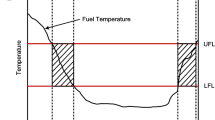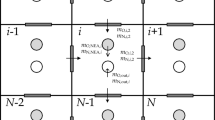Abstract
This paper aims to specify a methodology for an optimized inerting system conceptual design based on fuel tank flammability analysis defined by rules for commercial aircraft certification proposal to evaluate the impact on engine bleed consumption in a modernized commercial long-range aircraft model. This work was carried out according to the following steps: (1) estimation of aircraft geometric tank features from limited data; (2) development of tank thermal model to estimate bulk fuel temperature based on flight performance aircraft, fuel consumption/transfer in the tank, presence of heat sources and external airflow heat exchange; (3) flammability analysis based on Federal Aviation Administration (FAA) certification requirement methodology; (4) conception of an inerting system model as a flammability reduction means based on tank gas mixture model, onboard inert gas generation system publicly available data from FAA previous studies and proposed inerting gas distribution model; (5) incorporation of inerting system in the flammability model and reassessment of the fuel tank flammability; (6) analysis of the impact in engine bleed air consumption and specific fuel consumption due to the designed inerting system. As a final result, a methodology to increase the safety in aircraft operation was obtained, considering the current most common technology used to reduce the fuel tank flammability in commercial aircraft, the inerting system. This strategy is applicable for new aircraft in a development phase and also allows the accomplishment of modernizing designs for existing aircraft following current safety regulations.







Similar content being viewed by others
Abbreviations
- ASM:
-
Air separation modules
- APS:
-
Air preparation system
- CTR:
-
Center
- CWT:
-
Center wing tanks
- ECS:
-
Environmental conditioning system
- FRM:
-
Flammability reduction means
- FAA:
-
Federal Aviation Administration
- FAFE:
-
Fleet average flammability exposure
- FCV:
-
Flow control valve
- FEET:
-
Flammability exposure evaluation time
- FNmax:
-
Maximum available net thrust in the engine
- FTFAM:
-
Fuel tank flammability assessment method
- GND:
-
Ground
- HF:
-
High flow
- LF:
-
Low flow
- LFL:
-
Lower flammability limit
- NEA:
-
Nitrogen-enriched air
- OBIGGS:
-
Onboard inert gas generation system
- OEA:
-
Oxygen enriched
- SFC:
-
Specific fuel consumption
- TAT:
-
Total air temperature (Stagnation temperature)
- TIT:
-
Turbine inlet temperature
- UFL:
-
Upper flammability limit
References
National Transportation Safety Board—NTSB Publishing Web. In-flight Breakup Over the Atlantic Ocean Trans World Airlines Flight 800, Boeing 747-141, N93119 https://www.ntsb.gov/investigations/accidentreports/pages/aar0003.aspx
Society of Automotive Engineers (2008) AIR1903: aircraft inerting systems. Warrendale, PA
Society of Automotive Engineers (2012) ARP6078: aircraft fuel tank inerting systems. Warrendale, PA
Dostert M (2008) Design approval holder familiarization briefing—fuel tank flammability. FAA workshop content. http://www.fire.tc.faa.gov/systems/fueltank/course/files/Workshop/01FRMFamBriefing-Background.ppt
Fuel Flammability Task Group (1998) A review of the flammability hazard of jet fuel vapor in civil transport aircraft tanks. FAA report DOT/FAA/AR-98/26
Federal Aviation Administration—FAA (2008) Advisory circular AC 25.981-2A: fuel tank flammability reduction means
Cavage WM, Morrison R. Development and testing of the FAA simplified fuel tank inerting system—Federal Aviation Administration
Cavage WM (2002) Modeling inert gas distribution in commercial transport aircraft fuel tanks. American Institute of Aeronautics and Astronautics Journal
Burns M, Cavage W, Hill R, Morrison R (2004) Flight-testing of the FAA onboard inert gas generation system on an airbus A320, FAA report DOT/FAA/AR-03/58
Ahmad F, Lau KK, Lock SSM (2014) Hollow fiber membrane model for gas separation: process simulation, experimental validation and module characteristics. J Ind Eng Chem 21:1246–1257
Thundyil MJ, Koros WJ (1996) Mathematical modeling of gas separation permeators for radial crossflow, countercurrent, and concurrent hollow fiber membrane modules. J Membr Sci
Monsalve-Bravo G, Bhatia SK (2018) Comparison of hollow fiber and flat mixed matrix membranes: theory and simulation. Chem Eng Sci 187:174–188
Shao L, Liu W, Li C, Feng S, Wang C, Pan J (2018) Experimental comparison between aircraft fuel tank inerting processes using NEA and MIG. Chin J Aeronaut 31:1515–1524
Yan C, Xueqin B, Guiping L, Bing S, Yu Z, Zixuan L (2015) Experimental study of an aircraft fuel tank inerting system. Chin J Aeronaut 28:394–402
Li C, Feng S, Chen C, Peng X, Liu W (2019) Performance analysis of aircraft fuel tank inerting system with turbocharger. J Aerosp Eng 233:5217–5226
Keim M, Kallo J, Friedrich KA, Werner C, Saballus M, Gores F (2013) Multifunctional fuel cell system in an aircraft environment: an investigation focusing on fuel tank inerting and water generation. Aerosp Sci Technol 29:330–338
Feng S, Peng X, Chen C, Zhang R, Liu W (2020) Effect of air supplementation on the performance of an onboard catalytic inerting system. Aerosp Sci Technol 97:105605
Fonseca Filho V, Ribeiro R, Lacava P (2019) Turbofan engine performance optimization based on aircraft cruise thrust level. J Braz Soc Mech Sci Eng 41:64. https://doi.org/10.1007/s40430-018-1562-1
Airbus (2005) A330 Aircraft characteristics airport and maintenance planning. France
Aircraft families A330-300 AIRBUS Publishing Web. http://www.airbus.com/aircraftfamilies/passengeraircraft/a330family/a330-300/. Accessed 15 May 2015
Model CF6-80E1 engine overview. GE Aviation Publishing Web. http://www.geaviation.com/commercial/engines/cf6/. Accessed 21 May 2015
European Aviation Safety Agency-EASA (2011) CF6-80E1 engine type certificate data sheet. https://www.easa.europa.eu/system/files/dfu/EASA-TCDS-E.007_(IM)_General_Electric_CF6--80E1_Series_engines-02-25102011.pdf. Accessed 21 May 2015
Kurzke J (2012) Gasturb gas turbine performance—software package Ver. 12.0, Germany
Dassault Systèmes (2017) Catia V5, software package
Federal Aviation Administration—Lessons Learned From Civil Aviation Accidents Home. https://lessonslearned.faa.gov/ll_main.cfm?TabID=2&LLID=73&LLTypeID=2
Langton R et al (2009) Aircraft fuel system—aerospace series. Wiley, Wiltshire
Summer S (2008) Fuel tank flammability assessment method user’s manual—(FTFAM version 10 spreadsheet), FAA report DOT/FAA/AR-05/8
Electronic Code of Federal Regulations (2019) Title 14—Aeronautics and space, Chapter I, Subchapter C, Part 25—Airworthiness standards: transport category airplanes
Simcenter AMESim software package—version 14
PRISM® Membrane Dryers. Air Products Publishing Web. http://www.airproducts.com/~/media/Files/PDF/products/supply-options/prism-membrane/en-prism-cactus-PA3010-20-30-data-sheet.pdf
Reynolds T, Bailey D, Lewinski D, Roseburg C, Palaszewski B (2001) Onboard Inert Gas Generation System/Onboard Oxygen Gas Generation System (OBIGGS/OBOGS) study. NASA/CR-2001-210950/D950-10529-2
Author information
Authors and Affiliations
Corresponding author
Additional information
Technical Editor: André Cavalieri.
Publisher's Note
Springer Nature remains neutral with regard to jurisdictional claims in published maps and institutional affiliations.
Rights and permissions
Springer Nature or its licensor (e.g. a society or other partner) holds exclusive rights to this article under a publishing agreement with the author(s) or other rightsholder(s); author self-archiving of the accepted manuscript version of this article is solely governed by the terms of such publishing agreement and applicable law.
About this article
Cite this article
da Fonseca Filho, V.F., Lacava, P.T. Methodology for inerting system analysis in the long-range aircraft preliminary design phase. J Braz. Soc. Mech. Sci. Eng. 45, 91 (2023). https://doi.org/10.1007/s40430-023-04014-2
Received:
Accepted:
Published:
DOI: https://doi.org/10.1007/s40430-023-04014-2




